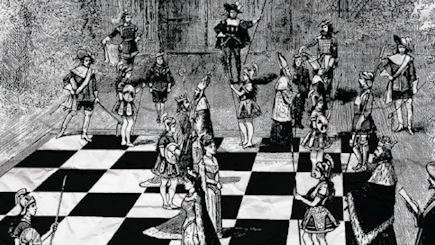This article first appeared in the May/Jun 2015 issue of WGM.
In previous installments of this series, I have given examples of players willing to risk life and limb for the sake of insane wagers – but what about a willingness to risk the lives of others? Sadly, there has been no shortage over the years.

Shah Jahan, the 17th Century Mughal Emperor of India and the man responsible for building the Taj Mahal, was fond of playing “living chess” in the grand courtyard of his palaces, with soldiers dressed up as game pieces. He would also, according to legend, play against a trusted courtier with 32 virgins used as game pieces instead – all of them going to the victor afterwards as spoils! The Chinese Emperor Ming Huang (712-756) was similarly inspired and it is said he would play chess against his favorite concubine, Yang Kwei-fei, with palace maids for pieces.
Such games were relatively harmless, but chess can get much more dangerous than that. For some, playing a game is always taken to the extreme. In the Viking epos Thorgil’s Saga from the 12th Century is a tale of Thorgil Skardi playing chess with Samur Magnusson. The pair get into a heated argument over the game and it all ends with Thorgil shoving the chess pieces into their leather bag and hitting Samur across the face so hard it draws blood.
But for sheer thrill-a-minute chess, it is hard to beat the Sultan Mulay Abdul el-Aziz bin Hassan, who ruled Morocco from 1894 to 1908 and was known as “the Mad One” for the simple reason that he was not clinically sane. He was widely known for his morbid way of playing the game, frequently for money against his courtiers.
In his residential palace, Hassan had a large chessboard made of stone slabs with the game pieces replaced by prisoners taken from the royal dungeons! What made these games particularly sadistic was the fact that a captured “game piece” was led off the board and beheaded on the spot with a sharp axe by Hassan’s chief executioner – a practice which must have had each prisoner watching the game very closely and desperately hoping their “piece” was spared!

Perhaps the cruelest dice game in history took place around the year 340 BC, according to the Greek historian Plutarch. The ruling King of the Persians, Artaxerxes, commanded his faithful eunuch slave Mesabetes to cut off the hand and head of Artaxerxes’ own brother, Cyrus, who had been found plotting to take over the throne. This enraged their mother Parysatis and she swore revenge on her surviving son and moreso poor Mesabetes who had simply been following orders.
Since Parysatis was a “skillful dice player” according to Plutarch, sometime later she arranged a game against Artaxerxes with the matter of Cyrus’ death seemingly forgotten. At first she bet, and lost, a considerable sum of money which she promptly paid up. Then, after claiming to have run out of coins, she suggested they play for slaves instead – something Artaxerxes quickly agreed to.

The sly Parysatis now made sure to turn her luck with the dice around and soon enough had won Mesabetes. That same evening, the unfortunate slave met a very grizzly end as Parysatis had him flayed alive in front of her entire court. When Artaxerxes protested, Parysatis simply laughed in his face and reminded him that she had taken her losses quietly so he should do the same!







